初中英语语法大全——状语从句(共24张PPT)
文档属性
| 名称 | 初中英语语法大全——状语从句(共24张PPT) |

|
|
| 格式 | ppt | ||
| 文件大小 | 2.4MB | ||
| 资源类型 | 教案 | ||
| 版本资源 | 通用版 | ||
| 科目 | 英语 | ||
| 更新时间 | 2022-04-10 10:41:30 | ||
图片预览


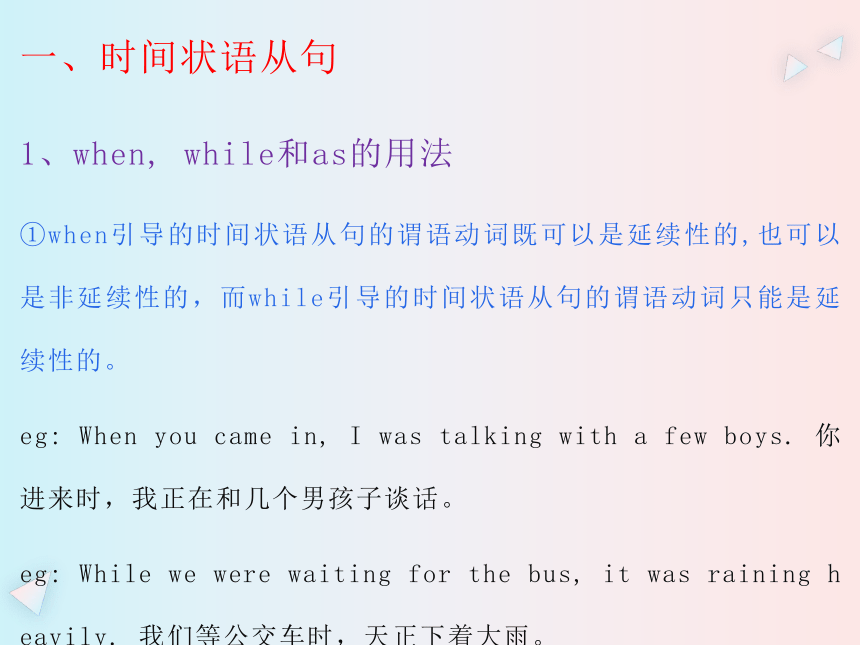
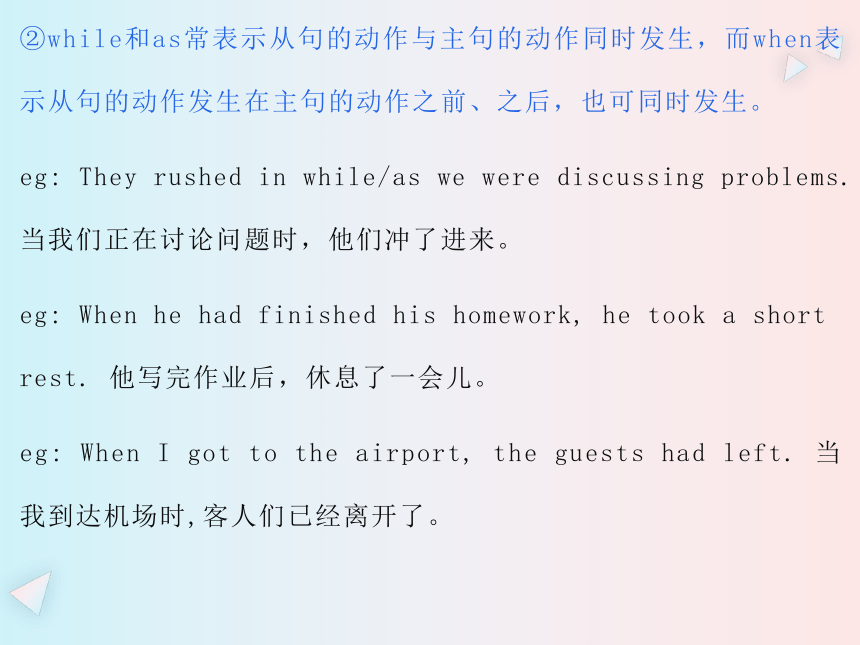
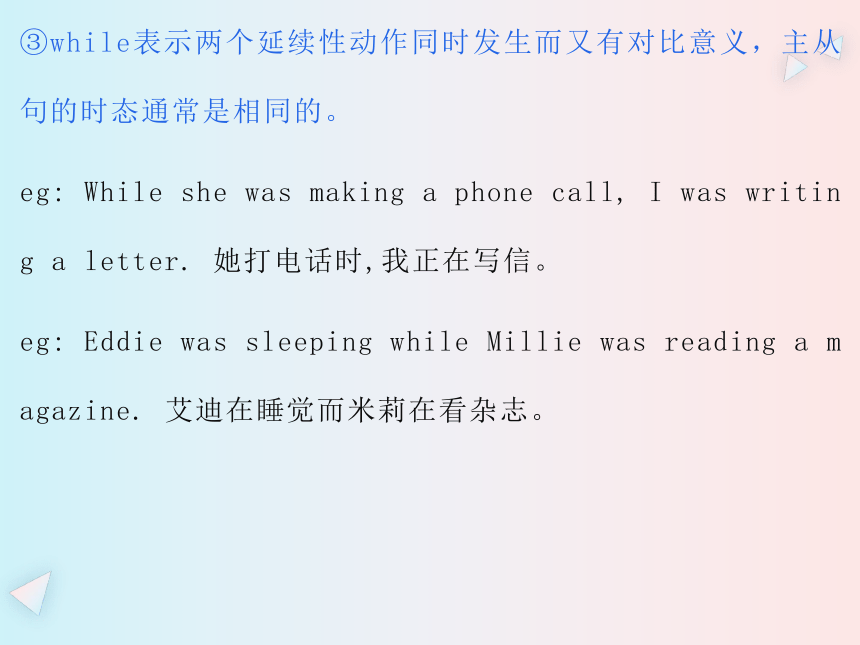
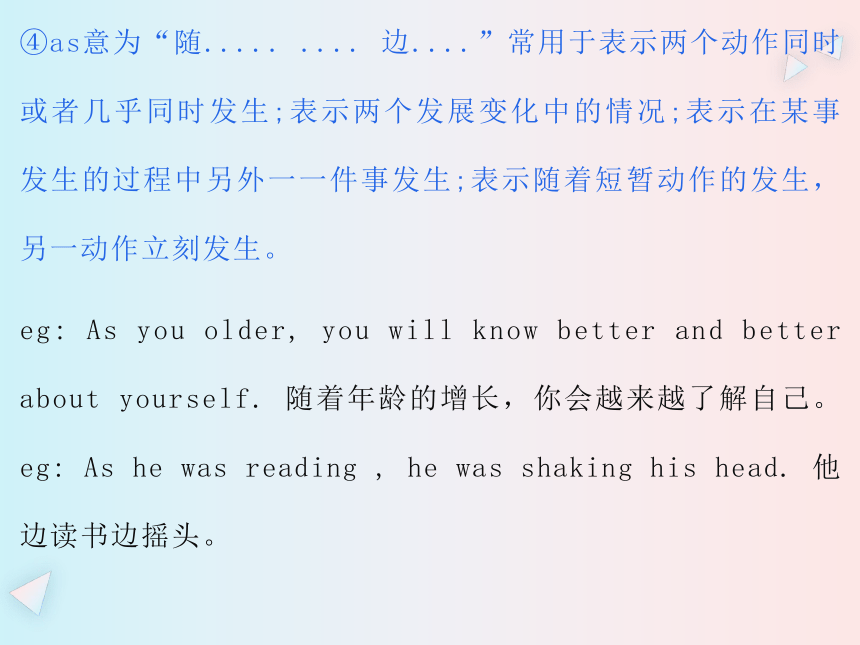

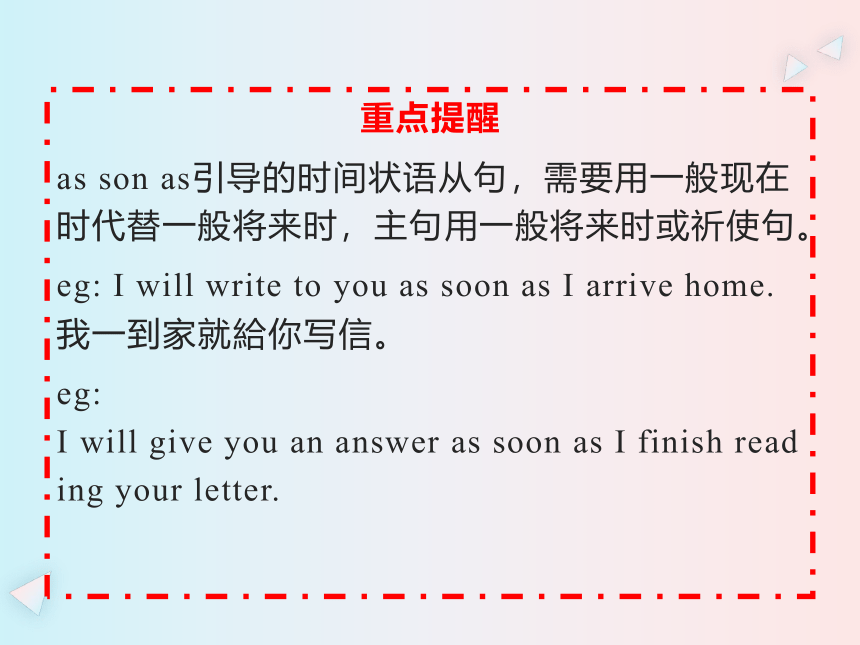
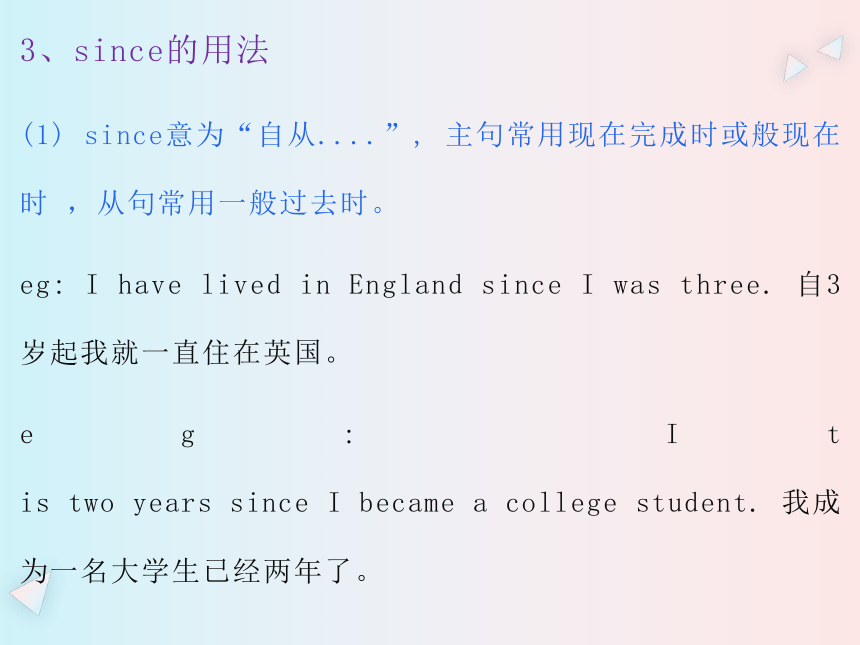
文档简介
(共24张PPT)
初中英语语法大全
状语从句
在句中起状语作用的从句叫作状语从句。状语从句可以位于句前、向中成向居。位于句首时,常用迅号与主句隔开,位于句中时以句前后须用过号,位于句居时,从句的前面可以不用逗号。
状语从句主要包括时间状语从句地点状语从句、条件状语从句、原因状语从句、目的状语从句、结果状语从句、让步状语从句方式状语从句和比较状语从句。
一、时间状语从句
1、when, while和as的用法
①when引导的时间状语从句的谓语动词既可以是延续性的,也可以是非延续性的,而while引导的时间状语从句的谓语动词只能是延续性的。
eg: When you came in, I was talking with a few boys. 你进来时,我正在和几个男孩子谈话。
eg: While we were waiting for the bus, it was raining heavily. 我们等公交车时,天正下着大雨。
②while和as常表示从句的动作与主句的动作同时发生,而when表示从句的动作发生在主句的动作之前、之后,也可同时发生。
eg: They rushed in while/as we were discussing problems. 当我们正在讨论问题时,他们冲了进来。
eg: When he had finished his homework, he took a short rest. 他写完作业后,休息了一会儿。
eg: When I got to the airport, the guests had left. 当我到达机场时,客人们已经离开了。
③while表示两个延续性动作同时发生而又有对比意义,主从句的时态通常是相同的。
eg: While she was making a phone call, I was writing a letter. 她打电话时,我正在写信。
eg: Eddie was sleeping while Millie was reading a magazine. 艾迪在睡觉而米莉在看杂志。
④as意为“随..... .... 边....”常用于表示两个动作同时或者几乎同时发生;表示两个发展变化中的情况;表示在某事发生的过程中另外一一件事发生;表示随着短暂动作的发生,另一动作立刻发生。
eg: As you older, you will know better and better about yourself. 随着年龄的增长,你会越来越了解自己。eg: As he was reading , he was shaking his head. 他边读书边摇头。
2. as soon as的用法
as soon as意为“一....就 ...”,表示从句的动作一发生 ,主句的动作随即发生。
eg: Mom, I'm leaving for Beijing tomorrow. --- That's nice. You'd better ring me up as soon as you get there.
eg: As soon as he heard the news, he jumped with joy.
重点提醒
as son as引导的时间状语从句,需要用一般现在时代替一般将来时,主句用一般将来时或祈使句。
eg: I will write to you as soon as I arrive home. 我一到家就給你写信。
eg: I will give you an answer as soon as I finish reading your letter.
3、since的用法
(1) since意为“自从....”, 主句常用现在完成时或般现在时 ,从句常用一般过去时。
eg: I have lived in England since I was three. 自3岁起我就一直住在英国。
eg: It is two years since I became a college student. 我成为一名大学生已经两年了。
4、until /till的用法
until/till意为“直到....为止”。当主句为否定句时,常构成“not...until...”结构,意为“直到......才......”
(1) 主句是否定句时
主句如果是否定句,谓语动词需用非延续性动词,表示主句的云作到从句表示的时间点才开始。
eg: You can't leave until you have finished your homework.
eg: I didn't know anything about it until you told me.
(2)主句是肯定句时
主句如果是肯定句,谓语动词需用延续性动词,表示主句的动作直到从句表示的时间点就结束。
eg: I will wait for you until/till you come back. 我会一直等,直到你回来。
eg: You may stay here until/till the rain stops. 你可以在这里一直待到雨停。
5. before, after的用法
before意为“.....之前”时,表示主句动作发生在从句动作之前。after意为“.....之后”,表示主句动作发生在从句动作之后。
eg: Please turn off the lights before you leave the classroom. 请在离开教室前关上灯。
eg: He arrived after the game started. 比赛开始后他才到。
二、地点状语从句
在句子中充当地点状语的从句称为地点状语从句。引导地点状语从句的从属连词主要有where( ...地方), wherever(无论问处)等,表示地点方位。
eg: I found all the missing things where I left them.
eg: Where there is a will, there is a way.
三. 条件状语从句
在句子中作条件状语的从句称为条件状语从句。条件状语从句可置于句首,也可置于句尾,有时还可以置于主语和谓语之间。条件状语从句主要由if(如果),unless(除非,如果....)。
eg:If Jenny goes to the concert, I will go, too. 如果珍妮去音乐会,我也去。
四. 原因状语从句
1. because的用法
because 表示的因果关系最强,常用来回答why提出的问题,意为“因为”。所引出的原因往往是说话者所不知道的或者最感兴趣的。because引导的原因状语从句往往比主句显得更重要。eg: I came back late yesterday because I was on duty. eg: Why didn't you give Dick a call --- Because I will see him soon.
2. since的用法
since表示人们已经知道的事实,不需要强调的原因,常意为“既然....”通常放在句首。since引导的从句是次要的,重点强调主从 句的内容。
eg: Since everyone is here, let's get started. 既然大家都来了,我们开始吧。
eg: Since you are free tonight. why not drop in and play chess with me
既然你今晚没事,为什么不来和我下棋呢
3. as的用法
as表示的原因只是对结果的附加说明,位于句首、句尾均可。as从句不可用于强调结构。
eg: She didn't hear us come in as she was asleep. 她睡着了,因此没有听见我们进来。
eg: As you weren't there, I left a message. 你不在,因此我给你留了一张字条。
五.结果状语从句
1. so... that...的用法
在so...that....结构中, so是副词,修饰形容词或副词。引导结果状语从句时,常用于以下结构:
形容词/副词
so+ many few(+复数可数名词) that+从句
much/ little(+不可数名词)
so+ 形容词+a(n)+单数可数名词+ that 从句
Kathy is so lovely that we all like to play with her.
He made so many mistakes that he failed the exam once again.
Such a little boy has so little difficulty in working out this problem that I admire him very much.
2. such...that...的用法
在such... that... 结构中,such是形容词,修饰名词或名词短语。引导结果状语从句时,常用于以下结构:
a(n)+形容词+单数可数名词
so+ such+ 形容词+复数可数名词 +that+从句
形容词+不可数名词
His plan was such a good one that we all agreed to accept it.
They are such kind-hearted teachers that people in the village all respect them.
We had such terrible weather that we couldn't finish the work on time.
六、目的状语从句
1. in order that和so that的用法
in order that常用于正式文体中。可置于句首,也可置于句尾。而so that往往只置于句尾。so that中的that有时可省略。从句中常有can, may, could, would等情态动词。
eg: She dressed like an angel so that everyone would notice her.
eg: You must speak loud in order that you can be heard by all.
七、让步状语从句
1. though, although的用法
though和although的意义相同,多数情况下可以互换使用。主句可用yet或still,更加强调对比性。
eg: We were not tired though we had worked all day. 虽然干了一天的活,但我们并不累。
eg: The article is very important although it is short. 文章虽然很短,但是很重要。
2. even if, even though的用法
even if, even though表示语气更强的让步,意为“即使”。even if更强调对“假设”的让步, even though更加强调对“既成事实”的让步。
eg: we'll make a tip even though the weather is bad.
eg: Even though he is 20, he is sill like a little child.
八、方式状语从句
1. as的用法
as引导方式状语从句,意为“..的方式,如同”。
eg: Will you do the experiment as I am doing 请按照我做的方法做这个实验好吗
eg: Leave the children as they are.让孩子们随便吧。
2. as if/as though的用法
两者引导的方式状语从句所表示的情况是事实或者具有很大的可能性时,通常用陈述语气;如果从句表示的情况不是事实,而是主观的想象,则用虚拟语气。
eg: He glanced about as if/ though he was in search of something他四处看了看,好像在找什么东西。
eg: It looks as if/though it were going to rain. 天看起来要下雨。
初中英语语法大全
状语从句
在句中起状语作用的从句叫作状语从句。状语从句可以位于句前、向中成向居。位于句首时,常用迅号与主句隔开,位于句中时以句前后须用过号,位于句居时,从句的前面可以不用逗号。
状语从句主要包括时间状语从句地点状语从句、条件状语从句、原因状语从句、目的状语从句、结果状语从句、让步状语从句方式状语从句和比较状语从句。
一、时间状语从句
1、when, while和as的用法
①when引导的时间状语从句的谓语动词既可以是延续性的,也可以是非延续性的,而while引导的时间状语从句的谓语动词只能是延续性的。
eg: When you came in, I was talking with a few boys. 你进来时,我正在和几个男孩子谈话。
eg: While we were waiting for the bus, it was raining heavily. 我们等公交车时,天正下着大雨。
②while和as常表示从句的动作与主句的动作同时发生,而when表示从句的动作发生在主句的动作之前、之后,也可同时发生。
eg: They rushed in while/as we were discussing problems. 当我们正在讨论问题时,他们冲了进来。
eg: When he had finished his homework, he took a short rest. 他写完作业后,休息了一会儿。
eg: When I got to the airport, the guests had left. 当我到达机场时,客人们已经离开了。
③while表示两个延续性动作同时发生而又有对比意义,主从句的时态通常是相同的。
eg: While she was making a phone call, I was writing a letter. 她打电话时,我正在写信。
eg: Eddie was sleeping while Millie was reading a magazine. 艾迪在睡觉而米莉在看杂志。
④as意为“随..... .... 边....”常用于表示两个动作同时或者几乎同时发生;表示两个发展变化中的情况;表示在某事发生的过程中另外一一件事发生;表示随着短暂动作的发生,另一动作立刻发生。
eg: As you older, you will know better and better about yourself. 随着年龄的增长,你会越来越了解自己。eg: As he was reading , he was shaking his head. 他边读书边摇头。
2. as soon as的用法
as soon as意为“一....就 ...”,表示从句的动作一发生 ,主句的动作随即发生。
eg: Mom, I'm leaving for Beijing tomorrow. --- That's nice. You'd better ring me up as soon as you get there.
eg: As soon as he heard the news, he jumped with joy.
重点提醒
as son as引导的时间状语从句,需要用一般现在时代替一般将来时,主句用一般将来时或祈使句。
eg: I will write to you as soon as I arrive home. 我一到家就給你写信。
eg: I will give you an answer as soon as I finish reading your letter.
3、since的用法
(1) since意为“自从....”, 主句常用现在完成时或般现在时 ,从句常用一般过去时。
eg: I have lived in England since I was three. 自3岁起我就一直住在英国。
eg: It is two years since I became a college student. 我成为一名大学生已经两年了。
4、until /till的用法
until/till意为“直到....为止”。当主句为否定句时,常构成“not...until...”结构,意为“直到......才......”
(1) 主句是否定句时
主句如果是否定句,谓语动词需用非延续性动词,表示主句的云作到从句表示的时间点才开始。
eg: You can't leave until you have finished your homework.
eg: I didn't know anything about it until you told me.
(2)主句是肯定句时
主句如果是肯定句,谓语动词需用延续性动词,表示主句的动作直到从句表示的时间点就结束。
eg: I will wait for you until/till you come back. 我会一直等,直到你回来。
eg: You may stay here until/till the rain stops. 你可以在这里一直待到雨停。
5. before, after的用法
before意为“.....之前”时,表示主句动作发生在从句动作之前。after意为“.....之后”,表示主句动作发生在从句动作之后。
eg: Please turn off the lights before you leave the classroom. 请在离开教室前关上灯。
eg: He arrived after the game started. 比赛开始后他才到。
二、地点状语从句
在句子中充当地点状语的从句称为地点状语从句。引导地点状语从句的从属连词主要有where( ...地方), wherever(无论问处)等,表示地点方位。
eg: I found all the missing things where I left them.
eg: Where there is a will, there is a way.
三. 条件状语从句
在句子中作条件状语的从句称为条件状语从句。条件状语从句可置于句首,也可置于句尾,有时还可以置于主语和谓语之间。条件状语从句主要由if(如果),unless(除非,如果....)。
eg:If Jenny goes to the concert, I will go, too. 如果珍妮去音乐会,我也去。
四. 原因状语从句
1. because的用法
because 表示的因果关系最强,常用来回答why提出的问题,意为“因为”。所引出的原因往往是说话者所不知道的或者最感兴趣的。because引导的原因状语从句往往比主句显得更重要。eg: I came back late yesterday because I was on duty. eg: Why didn't you give Dick a call --- Because I will see him soon.
2. since的用法
since表示人们已经知道的事实,不需要强调的原因,常意为“既然....”通常放在句首。since引导的从句是次要的,重点强调主从 句的内容。
eg: Since everyone is here, let's get started. 既然大家都来了,我们开始吧。
eg: Since you are free tonight. why not drop in and play chess with me
既然你今晚没事,为什么不来和我下棋呢
3. as的用法
as表示的原因只是对结果的附加说明,位于句首、句尾均可。as从句不可用于强调结构。
eg: She didn't hear us come in as she was asleep. 她睡着了,因此没有听见我们进来。
eg: As you weren't there, I left a message. 你不在,因此我给你留了一张字条。
五.结果状语从句
1. so... that...的用法
在so...that....结构中, so是副词,修饰形容词或副词。引导结果状语从句时,常用于以下结构:
形容词/副词
so+ many few(+复数可数名词) that+从句
much/ little(+不可数名词)
so+ 形容词+a(n)+单数可数名词+ that 从句
Kathy is so lovely that we all like to play with her.
He made so many mistakes that he failed the exam once again.
Such a little boy has so little difficulty in working out this problem that I admire him very much.
2. such...that...的用法
在such... that... 结构中,such是形容词,修饰名词或名词短语。引导结果状语从句时,常用于以下结构:
a(n)+形容词+单数可数名词
so+ such+ 形容词+复数可数名词 +that+从句
形容词+不可数名词
His plan was such a good one that we all agreed to accept it.
They are such kind-hearted teachers that people in the village all respect them.
We had such terrible weather that we couldn't finish the work on time.
六、目的状语从句
1. in order that和so that的用法
in order that常用于正式文体中。可置于句首,也可置于句尾。而so that往往只置于句尾。so that中的that有时可省略。从句中常有can, may, could, would等情态动词。
eg: She dressed like an angel so that everyone would notice her.
eg: You must speak loud in order that you can be heard by all.
七、让步状语从句
1. though, although的用法
though和although的意义相同,多数情况下可以互换使用。主句可用yet或still,更加强调对比性。
eg: We were not tired though we had worked all day. 虽然干了一天的活,但我们并不累。
eg: The article is very important although it is short. 文章虽然很短,但是很重要。
2. even if, even though的用法
even if, even though表示语气更强的让步,意为“即使”。even if更强调对“假设”的让步, even though更加强调对“既成事实”的让步。
eg: we'll make a tip even though the weather is bad.
eg: Even though he is 20, he is sill like a little child.
八、方式状语从句
1. as的用法
as引导方式状语从句,意为“..的方式,如同”。
eg: Will you do the experiment as I am doing 请按照我做的方法做这个实验好吗
eg: Leave the children as they are.让孩子们随便吧。
2. as if/as though的用法
两者引导的方式状语从句所表示的情况是事实或者具有很大的可能性时,通常用陈述语气;如果从句表示的情况不是事实,而是主观的想象,则用虚拟语气。
eg: He glanced about as if/ though he was in search of something他四处看了看,好像在找什么东西。
eg: It looks as if/though it were going to rain. 天看起来要下雨。
同课章节目录
- 词法
- 名词
- 动词和动词短语
- 动词语态
- 动词时态
- 助动词和情态动词
- 非谓语动词
- 冠词
- 代词
- 数词和量词
- 形容词副词及其比较等级
- 介词和介词短语
- 连词和感叹词
- 构词法
- 相似、相近词比较
- 句法
- 陈述句
- 一般疑问句和否定疑问句
- 特殊疑问句及选择疑问句
- 反意疑问句
- 存在句(There be句型)
- 宾语从句
- 定语从句
- 状语从句
- 主谓一致问题
- 简单句
- 并列句
- 复合句
- 主谓一致
- 主、表语从句
- 名词性从句
- 直接引语和间接引语
- 虚拟语气
- 感叹句
- 强调句
- 倒装句
- 祈使句
- 句子的成分
- 句子的分类
- 题型专区
- 单项选择部分
- 易错题
- 完形填空
- 阅读理解
- 词汇练习
- 听说训练
- 句型转换
- 补全对话
- 短文改错
- 翻译
- 书面表达
- 任务型阅读
- 语法填空
- 其他资料
